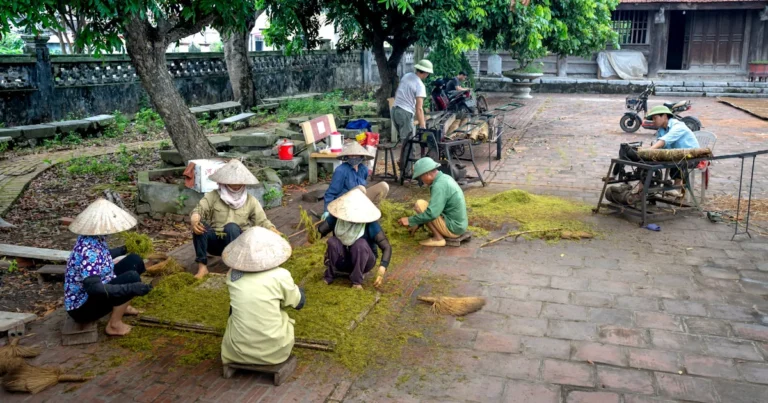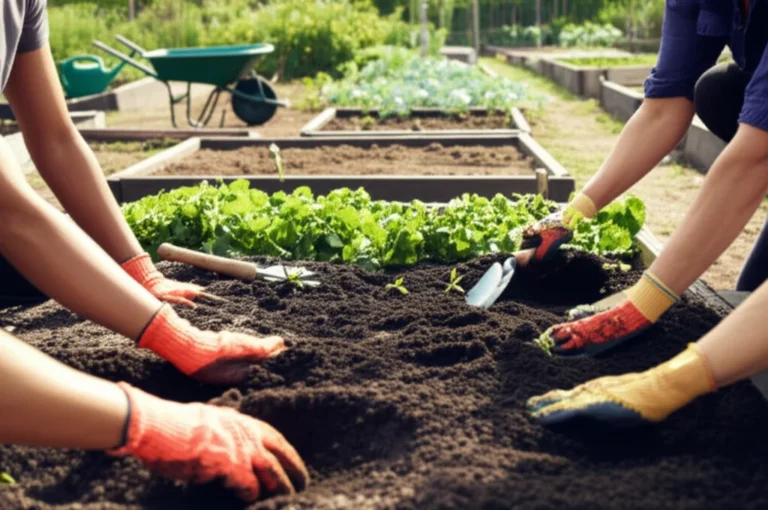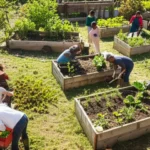Support our educational content for free when you purchase through links on our site. Learn more
Imagine stepping into a vibrant patch of green in the heart of a Texas city—rows of tomatoes, buzzing bees, neighbors sharing gardening tips, and the scent of fresh earth. But before you grab your gloves and trowel, you might be wondering: Are community gardens actually free in Texas? The answer isn’t as simple as a yes or no. From city programs offering free plots to private gardens charging fees, the landscape is as varied as the Lone Star State itself.
Did you know that urban community gardens in Texas have surged by over 40% in the last decade? Yet, many newcomers are surprised to learn that while some gardens welcome you with open (and free) arms, others require a small investment or volunteer commitment. In this article, we’ll unpack the costs, benefits, and insider tips on how to find or start a community garden that fits your budget and lifestyle. Plus, we’ll share stories of Texas gardeners who’ve turned dirt into community gold—and how you can join them.
Key Takeaways
- Community gardens in Texas are often free or low-cost, but fees vary based on location, ownership, and amenities.
- City programs like Austin’s Community Gardens offer grants and free plots, especially when you volunteer.
- Joining a community garden brings health, social, and environmental benefits beyond just fresh produce.
- Sustainable gardening practices are key in Texas’s climate, including smart watering and soil care.
- Starting your own garden is possible with local resources and community support—we guide you step-by-step.
Ready to dig in? Whether you want to find a free plot or start your own garden oasis, we’ve got the dirt on everything you need to know.
👉 Shop Gardening Essentials:
Table of Contents
- ⚡️ Quick Tips and Facts About Community Gardens in Texas
- 🌱 Growing Together: The Rich History and Evolution of Community Gardens in Texas
- ❓ Are Community Gardens Free in Texas? Understanding Costs, Fees, and Access
- 🏙️ How Texas Cities Support Community Gardens: Programs, Grants, and Partnerships
- 🌿 7 Benefits of Joining a Community Garden in Texas: Health, Social, and Environmental Perks
- 🧑🌾 Old and Young, Novice or Pro: Why Gardening Together Builds Strong Texas Communities
- 🍅 Heirloom Tomatoes and Texas Gardens: History, Growing Tips, and Delicious Recipes
- 🍰 Homestead Cake and Garden-to-Table Traditions in Texas
- 🌻 Personal Stories from Texas Gardeners: Why We Love Growing Food Together
- 🌎 Sustainable Gardening Practices for Texas Community Gardens: Water, Soil, and Climate Tips
- 🛠️ How to Start Your Own Community Garden in Texas: Step-by-Step Guide and Resources
- 🌟 Success Stories: Thriving Community Gardens Across Texas Cities
- 📚 Recommended Links for Texas Community Gardeners
- ❓ Frequently Asked Questions About Texas Community Gardens
- 🔗 Reference Links and Resources
⚡️ Quick Tips and Facts About Community Gardens in Texas
Welcome to the green heart of Texas! If you’re wondering are community gardens free in Texas?, you’re not alone. The short answer: it depends—but don’t let that stop you from digging in! 🌱
Here’s what we’ve learned at Community Gardening™ from years of hands-in-the-dirt experience and conversations with Texas gardeners:
- ✅ Many community gardens offer free or low-cost plots, especially those run by nonprofits or city programs.
- ❌ Some gardens charge nominal fees to cover water, soil amendments, or maintenance.
- 🌿 Community gardens come in many flavors: individual plots, communal beds, food forests, and teaching gardens.
- 📈 Gardening is booming in Texas—urban gardens have increased dramatically, mirroring national trends where city garden plots grew 44% since 2012 (source).
- 🏙️ Cities like Austin support community gardens with grants, volunteer coordination, and liability insurance (Austin Community Gardens Program).
- 🌞 Texas’s climate demands smart watering and soil care—think mulching and drought-tolerant plants.
- 🧑🌾 Community gardens are about more than food—they build social bonds, teach skills, and boost mental health.
For a deep dive into the nitty-gritty of costs, benefits, and how to get involved, keep reading! And if you want to jump right into the details about costs and access, check out our dedicated article on Are Community Gardens Free?
🌱 Growing Together: The Rich History and Evolution of Community Gardens in Texas
Community gardens in Texas aren’t just patches of dirt—they’re living stories. From the early homesteads where families grew heirloom tomatoes and native herbs, to modern urban farms in Austin and Houston, these gardens reflect Texas’s diverse culture and history.
The Roots of Texas Community Gardening
- Early settlers and homesteaders cultivated small plots for survival, often sharing seeds and knowledge with neighbors.
- The Great Depression saw a resurgence of “Victory Gardens,” where communities banded together to grow food amid hardship.
- In recent decades, urbanization sparked a new wave of community gardens focused on food justice, sustainability, and education.
Modern Milestones
- The City of Austin’s Community Gardens Program (2009) streamlined garden permits and fostered partnerships with nonprofits (source).
- Texas A&M AgriLife Extension’s “Growing and Nourishing Healthy Communities” program empowers gardeners with science-backed techniques and resources (source).
- Nonprofits like the Peterson Garden Project and local initiatives such as the Dr. Pound Historical Farmstead Garden in Dripping Springs highlight community-driven stewardship and education (source).
Texas gardens are a patchwork quilt of tradition and innovation—where old homestead wisdom meets urban sustainability. Ready to plant your own roots? Keep reading!
❓ Are Community Gardens Free in Texas? Understanding Costs, Fees, and Access
Ah, the million-dollar question—or rather, the zero-dollar question! Are community gardens free in Texas? The answer is nuanced, so let’s break it down.
What Influences Cost?
- Land Ownership: Gardens on city-owned land often have subsidized or free plots, but may require membership or volunteer hours.
- Nonprofit vs. Private: Nonprofit-run gardens tend to offer free or low-cost access, while private or commercial gardens may charge fees.
- Maintenance and Utilities: Some gardens charge fees to cover water, soil amendments, tools, and insurance.
- Plot Size and Amenities: Larger plots or those with raised beds and irrigation may cost more.
| Type of Garden | Typical Cost Range | Notes |
|---|---|---|
| City-Supported Gardens | Free to $20 per season | Often require volunteer commitment |
| Nonprofit Community Gardens | Free to $30 per season | May include educational programs |
| Private/Commercial Gardens | $25 to $100+ per season | Amenities like raised beds, water included |
| Food Forests/Orchards | Usually free or donation-based | Communal tending, no individual plots |
Examples from Texas
- The Coalition of Austin Community Gardens lists 29 city-endorsed gardens, many offering free or low-cost plots with volunteer agreements (source).
- The Dr. Pound Historical Farmstead Garden in Dripping Springs is a volunteer-built garden focusing on native and heirloom plants; access details vary (source).
- Some gardens, like Shiloh Field in Denton, provide free farm-to-table food for those in need (source).
Pro Tips for Finding Free or Affordable Gardens
- Contact local city programs or nonprofits.
- Volunteer your time in exchange for a plot.
- Look for gardens with shared communal beds.
- Explore faith-based or school gardens that welcome community members.
Want to know how to get started with your own garden or find one near you? We’ve got you covered later in this post!
🏙️ How Texas Cities Support Community Gardens: Programs, Grants, and Partnerships
Texas cities are increasingly recognizing community gardens as vital green spaces that promote health, sustainability, and social equity. Here’s how they’re pitching in:
City Programs and Ordinances
- Austin’s Urban Farm Ordinance (2009) simplified the process for establishing community gardens on city land and supports long-term stewardship (source).
- Cities provide grants and funding to nonprofits and community groups to build and maintain gardens.
- Some cities offer liability insurance and volunteer coordination to ease administrative burdens.
Partnerships with Nonprofits
- Organizations like the Peterson Garden Project in Chicago inspire similar models in Texas, providing tools, seeds, and educational workshops.
- Local groups collaborate with Texas A&M AgriLife Extension for technical support and gardening courses (source).
Volunteer and Community Engagement
- Many city-supported gardens require or encourage volunteer hours as part of plot agreements.
- Community events, workshops, and harvest festivals build social ties and share knowledge (Community Garden Events).
Texas cities are planting seeds for a greener, healthier future—one garden at a time. Interested in tapping into these resources? We’ll show you how in the “How to Start Your Own Community Garden” section.
🌿 7 Benefits of Joining a Community Garden in Texas: Health, Social, and Environmental Perks
Community gardens are more than just places to grow food—they’re hubs of health, happiness, and hope. Here are seven reasons why Texans are flocking to community gardens:
- Fresh, Nutritious Food: Grow your own fruits and veggies, reducing reliance on store-bought produce.
- Physical Activity: Gardening is a low-impact workout that improves strength, flexibility, and endurance.
- Mental Wellness: Time in nature lowers stress, anxiety, and depression.
- Social Connection: Meet neighbors, share tips, and build friendships across generations and cultures.
- Environmental Stewardship: Gardens improve air quality, support pollinators, and reduce urban heat islands.
- Educational Opportunities: Learn about sustainable gardening, composting, and native plants (Edible Plants).
- Community Empowerment: Gardens foster food security and resilience, especially in underserved areas.
Our gardeners often share stories of how a simple plot transformed their lives—from a retired teacher finding joy in heirloom tomatoes to a family teaching kids where food comes from. It’s a win-win for body, mind, and community!
🧑🌾 Old and Young, Novice or Pro: Why Gardening Together Builds Strong Texas Communities
One of the most magical things about community gardens is how they bring together people of all ages and skill levels. At Community Gardening™, we’ve seen firsthand how this mix creates a vibrant learning environment and a sense of belonging.
Intergenerational Wisdom Sharing
- Older gardeners pass down traditional techniques and stories about heirloom varieties.
- Younger gardeners bring new ideas, tech-savvy tools, and energy.
Learning by Doing
- Novices get hands-on experience with guidance from seasoned growers.
- Experienced gardeners refine skills and mentor others, strengthening community ties.
Building Social Capital
- Shared workdays and harvest celebrations create friendships and mutual support networks.
- Gardens often become safe spaces for youth programs, senior activities, and cultural events.
This communal spirit echoes the old homestead family values—neighbors helping neighbors, growing together, and embracing the past while cultivating the future.
🍅 Heirloom Tomatoes and Texas Gardens: History, Growing Tips, and Delicious Recipes
If you’ve ever bitten into a juicy, flavorful heirloom tomato, you know why they’re garden stars. Texas gardeners cherish heirlooms for their rich history and taste.
History of Heirloom Tomatoes in Texas
- Many heirlooms trace back to early settlers and indigenous varieties adapted to Texas’s climate.
- Varieties like Brandywine, Cherokee Purple, and Green Zebra are favorites among Texas growers.
Growing Tips for Texas Gardens
- Choose disease-resistant varieties suited for hot, humid summers.
- Plant in well-drained soil with plenty of organic matter.
- Use mulch to retain moisture and reduce weeds.
- Water deeply but infrequently to encourage strong roots.
- Stake or cage plants to keep fruit off the ground.
Delicious Recipes to Celebrate Your Harvest
- Heirloom Tomato Salad: Toss sliced tomatoes with fresh basil, mozzarella, olive oil, and balsamic vinegar.
- Texas-Style Salsa: Combine diced heirlooms with jalapeños, onions, cilantro, lime juice, and salt.
- Garden Fresh Gazpacho: Blend heirloom tomatoes with cucumber, bell pepper, garlic, and a splash of vinegar for a refreshing soup.
Want more edible plant inspiration? Check out our Edible Plants section for recipes and growing guides.
🍰 Homestead Cake and Garden-to-Table Traditions in Texas
Nothing says Texas homestead like a slice of homemade cake made with garden-fresh ingredients. Community gardens revive these traditions by reconnecting us to the land and our food.
What is Homestead Cake?
- A rustic, often fruit- or vegetable-based cake using seasonal garden bounty—think zucchini, carrots, or fresh berries.
- Recipes passed down through families, reflecting local flavors and history.
Why It Matters
- Baking with garden ingredients celebrates seasonality and self-sufficiency.
- It’s a delicious way to share the fruits of your labor with friends and neighbors.
Try This Simple Garden Cake Recipe
- Grate fresh zucchini or carrots from your garden.
- Mix with flour, eggs, sugar, cinnamon, and a touch of oil.
- Bake until golden and fragrant.
- Top with cream cheese frosting or a dusting of powdered sugar.
This cake is a sweet reminder that gardening nourishes both body and soul. For more garden-inspired recipes and ideas, explore our Garden Design Ideas and Edible Plants categories.
🌻 Personal Stories from Texas Gardeners: Why We Love Growing Food Together
At Community Gardening™, we treasure the stories that sprout alongside the plants. Here are a few voices from Texas gardens that capture the heart of community gardening:
- “Joining a community garden in Austin gave me more than fresh veggies—it gave me friends, purpose, and a deeper connection to my city.” — Maria, Austin
- “As a retired teacher, I love sharing heirloom tomato seeds and stories with kids at our local garden. It’s like passing on a family legacy.” — James, Houston
- “Gardening helped me heal after a tough year. The soil, the sun, the community—it’s therapy you can eat!” — Tanya, Dallas
These stories remind us that community gardens are about growth in every sense—food, friendships, and futures. Want to share your story or find a garden near you? Check out our Community Garden Events and Benefits of Community Gardens for inspiration and connection.
🌎 Sustainable Gardening Practices for Texas Community Gardens: Water, Soil, and Climate Tips
Texas’s climate can be a tough boss—hot summers, unpredictable rains, and sometimes poor soil. But with smart sustainable practices, community gardens thrive and conserve precious resources.
Water-Wise Gardening
- Use drip irrigation or soaker hoses to minimize evaporation.
- Collect rainwater with barrels or cisterns.
- Mulch heavily to retain soil moisture.
- Plant drought-tolerant natives and edible perennials.
Soil Health and Composting
- Test soil pH and nutrient levels regularly (Texas A&M Soil Testing Lab).
- Amend soil with organic compost—Texas A&M Extension offers great guides on composting (source).
- Rotate crops to prevent disease and nutrient depletion.
Climate-Smart Planting
- Choose varieties adapted to Texas heat and humidity.
- Use shade cloths or plant taller crops to protect sensitive plants.
- Schedule planting to avoid peak summer heat when possible.
Sustainability isn’t just good for the planet—it saves money and effort, making community gardens more accessible and resilient. For detailed tips, explore our Garden Design Ideas and Community Garden Policies sections.
🛠️ How to Start Your Own Community Garden in Texas: Step-by-Step Guide and Resources
Ready to roll up your sleeves and start your own community garden? Here’s a detailed roadmap from Community Gardening™ experts:
Step 1: Gather Your Team
- Find like-minded neighbors, local nonprofits, or faith groups.
- Form a planning committee to share responsibilities.
Step 2: Find and Secure Land
- Contact your city’s parks department or local government about available land.
- Consider private landowners willing to lease or donate space.
- Check zoning laws and permits—Austin’s Urban Farm Ordinance is a great model (source).
Step 3: Plan Your Garden Design
- Decide on plot types: individual, communal, raised beds, or food forest.
- Assess soil quality and water access.
- Design paths, tool sheds, compost bins, and seating areas (Garden Design Ideas).
Step 4: Fundraise and Apply for Grants
- Look for city grants, nonprofit funding, or crowdfunding.
- Partner with organizations like Texas A&M AgriLife Extension for resources (source).
Step 5: Build and Plant
- Organize volunteer workdays to build beds, install irrigation, and prepare soil.
- Choose plants suited to your climate and community needs.
Step 6: Establish Rules and Community Agreements
- Set plot fees (if any), volunteer expectations, and maintenance schedules.
- Create a communication plan for members.
Step 7: Celebrate and Educate
- Host planting parties, workshops, and harvest festivals to build community spirit.
Starting a garden is a rewarding challenge, but you’re never alone. Reach out to local coalitions like the Coalition of Austin Community Gardens for support.
🌟 Success Stories: Thriving Community Gardens Across Texas Cities
Texas is blooming with inspiring community garden success stories that prove the power of collective green thumbs.
Austin: The Urban Farm Movement
- With 29 city-endorsed gardens, Austin leads the way in urban agriculture. Gardens like Rosewood Community Garden and Rosewood Food Forest combine education, food production, and social justice (source).
Houston: Healing Through Gardening
- The Houston Community Garden Coalition supports gardens in underserved neighborhoods, improving food access and community health.
- Gardens often partner with local schools and health clinics for educational programs.
Dallas: Revitalizing Neighborhoods
- Community gardens in Dallas have transformed vacant lots into vibrant green spaces, reducing crime and increasing property values.
- The Dallas Community Garden Program emphasizes inclusivity and sustainability.
San Antonio: Cultural Roots and Food Security
- Gardens celebrate the city’s rich cultural heritage by growing native plants and traditional crops.
- Programs focus on food sovereignty and youth engagement.
These success stories show that community gardens are more than plots—they’re catalysts for change, growth, and connection. Want to find a thriving garden near you? Explore our Community Garden Events calendar.
📚 Recommended Links for Texas Community Gardeners
Ready to dig deeper? Here are top resources we recommend for Texas community gardeners:
- Coalition of Austin Community Gardens — Connect with local gardens and resources.
- Texas A&M AgriLife Extension Service — Expert advice, courses, and fact sheets.
- City of Austin Community Gardens Program — Grants, permits, and support.
- Peterson Garden Project — Nonprofit model for urban gardening.
- USDA Community Food Projects — Funding opportunities and programs.
- Community Gardening™ Benefits of Community Gardens — Articles on health, social, and environmental benefits.
Bookmark these links—they’re your toolkit for success!
❓ Frequently Asked Questions About Texas Community Gardens
Q: Do I need a permit to start a community garden in Texas?
A: Generally, no permit is needed for gardens on private land. City land may require permits or agreements—check local regulations, such as Austin’s Urban Farm Ordinance (source).
Q: Are community garden plots always free?
A: Not always. Many are free or low-cost, but some charge fees to cover water, soil, or maintenance. Volunteer hours often offset costs.
Q: Can I grow any plants I want?
A: Most gardens have guidelines—usually edible plants, native species, and no invasive plants. Check your garden’s rules.
Q: How do I find a community garden near me?
A: Contact local city programs, nonprofits, or visit the Coalition of Austin Community Gardens for listings.
Q: What if I’m a beginner?
A: Community gardens welcome all skill levels! Many offer workshops and mentorship. Texas A&M AgriLife Extension’s programs are a great resource (source).
🔗 Reference Links and Resources
- Cindy Heath, A New Texas Community Garden: https://www.cindyheathwrites.com/lets-eat/a-new-texas-community-garden
- City of Austin Community Gardens Program: https://www.austintexas.gov/department/community-gardens-program
- Texas A&M AgriLife Extension – Growing and Nourishing Healthy Communities: https://aggie-horticulture.tamu.edu/growing-and-nourishing-healthy-communities/
- Coalition of Austin Community Gardens: http://communitygardensaustin.org/
- Peterson Garden Project: https://www.petersongardenproject.org/
- USDA Community Food Projects: https://nifa.usda.gov/program/community-food-projects-cfp-grants
- Texas A&M Soil Testing Lab: https://soiltesting.tamu.edu/
Ready to get your hands dirty and your heart full? Stay tuned for our conclusion and next steps! 🌻
Conclusion
So, are community gardens free in Texas? The honest truth is—it depends! But here’s the bottom line from your Community Gardening™ experts: community gardens are generally affordable, often free or low-cost, and well worth the investment of time and effort. Whether you’re a seasoned green thumb or a curious newbie, Texas offers a rich tapestry of gardens supported by cities, nonprofits, and passionate volunteers.
We’ve uncovered how cities like Austin provide grants and support, how heirloom tomatoes and homestead traditions enrich our gardens, and how community gardens build bridges across generations and cultures. Plus, with programs like Texas A&M AgriLife Extension’s Growing and Nourishing Healthy Communities, you have access to expert guidance and resources to make your garden thrive.
If you’re itching to start your own garden or join an existing one, remember: the true cost is often your commitment and community spirit, not just dollars. And the rewards? Fresh food, friendships, and a healthier planet. 🌎
Keep exploring, keep planting, and keep growing together—because in Texas, community gardens are more than dirt and seeds; they’re the roots of a vibrant, sustainable future.
Recommended Links for Texas Gardeners
Ready to dig deeper or gear up? Here are some top picks and must-have resources:
-
Start a Community Food Garden – The Essential Handbook by LaManda Joy
-
Peterson Garden Project (Chicago-based nonprofit inspiring urban gardens)
-
Texas A&M AgriLife Extension – Growing and Nourishing Healthy Communities Program
-
Gardening Tools and Supplies on Amazon
-
Homestead Cake Recipe Books
Frequently Asked Questions About Texas Community Gardens
How do I find a community garden in Texas?
Finding a community garden near you is easier than you think! Start by contacting your city’s parks or urban agriculture department. For example, Austin’s Community Gardens Program maintains a list of city-endorsed gardens (source). Nonprofit coalitions like the Coalition of Austin Community Gardens also provide directories and resources. Local libraries, community centers, and faith-based organizations often have bulletin boards or newsletters with garden info. Online platforms and social media groups focused on urban gardening can connect you with neighbors and garden coordinators.
What are the benefits of joining a community garden in my local Texas neighborhood?
Joining a community garden offers fresh, nutritious produce, physical activity, and mental health benefits. It fosters social connections by bringing together diverse neighbors and encourages environmental stewardship through sustainable practices. Gardens often serve as educational hubs where you can learn about native plants, composting, and seasonal planting. For underserved communities, gardens improve food security and empower residents to take control of their food sources. Plus, it’s a great way to enjoy Texas’s unique climate and grow crops suited to local conditions.
Do I need to pay a fee to participate in a community garden in Texas?
Fees vary widely. Many community gardens, especially those on city or nonprofit land, offer free or low-cost plots. Some charge nominal fees to cover water, soil amendments, or maintenance. Volunteer hours often substitute for fees, creating a fair exchange of time and resources. Private or commercial gardens may have higher fees but often provide amenities like raised beds, irrigation, and tools. Always check with the garden coordinator for specific policies.
What are the rules and regulations for maintaining a plot in a Texas community garden?
Rules differ by garden but generally include:
- Growing edible or native plants only.
- Maintaining your plot by weeding, watering, and harvesting regularly.
- Participating in community workdays or meetings.
- Following organic or sustainable practices, avoiding harmful chemicals.
- Respecting shared spaces and tools.
- Abiding by any local ordinances or permits if applicable.
Clear communication and cooperation keep gardens thriving and enjoyable for all.
How can I start my own community garden in Texas?
Starting a garden involves gathering a committed group, securing land (public or private), designing the garden layout, fundraising or applying for grants, and establishing community guidelines. Cities like Austin offer support and resources to help you navigate permits and partnerships (source). Programs like Texas A&M AgriLife Extension provide technical expertise and training (source). Remember, community engagement and clear communication are key to long-term success.
Reference Links and Resources
- Cindy Heath, A New Texas Community Garden: https://www.cindyheathwrites.com/lets-eat/a-new-texas-community-garden
- City of Austin Community Gardens Program: https://www.austintexas.gov/department/community-gardens-program
- Texas A&M AgriLife Extension – Growing and Nourishing Healthy Communities: https://aggie-horticulture.tamu.edu/growing-and-nourishing-healthy-communities/
- Coalition of Austin Community Gardens: http://communitygardensaustin.org/
- Peterson Garden Project: https://www.petersongardenproject.org/
- USDA Community Food Projects: https://nifa.usda.gov/program/community-food-projects-cfp-grants
- Texas A&M Soil Testing Lab: https://soiltesting.tamu.edu/
Ready to grow your community and your garden? Let’s get planting! 🌻





